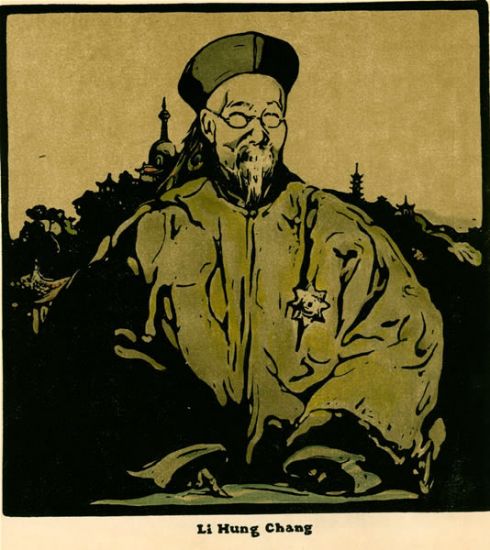
£450
Li Hung Chang
Unmounted (ref: 2620)
Lithographic reproduction of a hand-coloured woodcut,
10 x 9 1/8 in. (25.4 x 23 cm.)

Lithographic reproduction of a hand-coloured woodcut,
10 x 9 1/8 in. (25.4 x 23 cm.)
Provenance: Private Collection
Published by William Heinemann 1899 (September)
Inscribed on the stone, upper left 'William Nicholson' and beneath, 'Li Hung Chang'
Li Hung Chang
The Twelve Portraits series
was published in September 1899 in two editions: a portfolio of
hand-coloured woodcuts and a portfolio of lithographic reproductions
mounted ready for framing. The majority of the prints had initially
been conceived as individual works, and it was expedience alone that
brought them together in a set; but the series in its published form is
not without homogeneity. Certainly it fulfilled its aim of portraying a
representative selection of the most notable men and women of the day.
`A few years hence,' claimed a reviewer in the 9 December 1899 issue of
Literature, `Mr Nicholson's portfolio of Twelve Portraits ... will be of undoubted historical value.' Perhaps this was going too far, but mans- critics believed that Twelve Portraits contained Nicholson's best work, and indeed it was this series that was to earn the artist a gold medal at the Exposition Universelle in Paris in 1900.
Hongzhang, Marquis Suyi of the First Class, GCVO, (February 15, 1823 –
November 7, 1901) was a Chinese general who ended several major
rebellions, and a leading statesman of the late Qing Empire. He served
in important positions of the Imperial Court, once holding the office of
the Viceroy of Zhili.
He was best known in the west for his diplomatic negotiation skills.
Since 1894 First Sino-Japanese War, Li had become a literary symbol for
China's embarrassments in the late Qing Dynasty. His image in China
remains largely controversial, with most criticizing his lack of
political insight and his failure to win a single external military
campaign against foreign powers, but praising his role as a pioneer of
industrial and military modernization in Late Qing, his diplomatic
skills and his internal military campaigns against the Taiping
Rebellion.
Early in 1901 a second series of 12 portraits was proposed. Heinemann
sent Nicholson a list of suggested sitters in July, but work on the
project proceeded very slowly and it was not until the summer of 1902
that the portraits were finally delivered. Nicholson, always ready to
re-use existing material, commandeered his Lord Kitchener (1898) and
William 11 (1899) for this series (the latter was published in a
slightly revised form), and also made use of studies of Thomas Edison,
Theodore Roosevelt and Mark Twain made in New York in the autumn of
1900. The remaining seven portraits were conceived and executed in
1901/2: Queen Alexandra , Joseph Chamberlain (Colonial Secretary
at the time of the Boer War), Li-Hung Chang (the Chinese statesman),
Henrik Ibsen (whose plays Heinemann published in English translations),
Sada Yacco (the Japanese actress who modelled for Rodin), Eleonora
Dose (the great Italian tragedienne), and Pope Leo XIII.